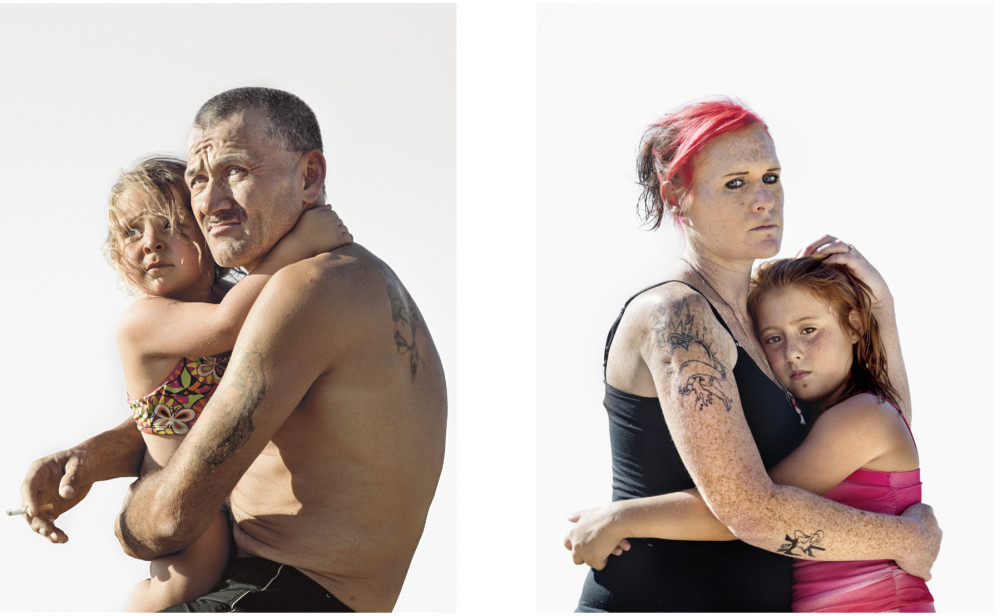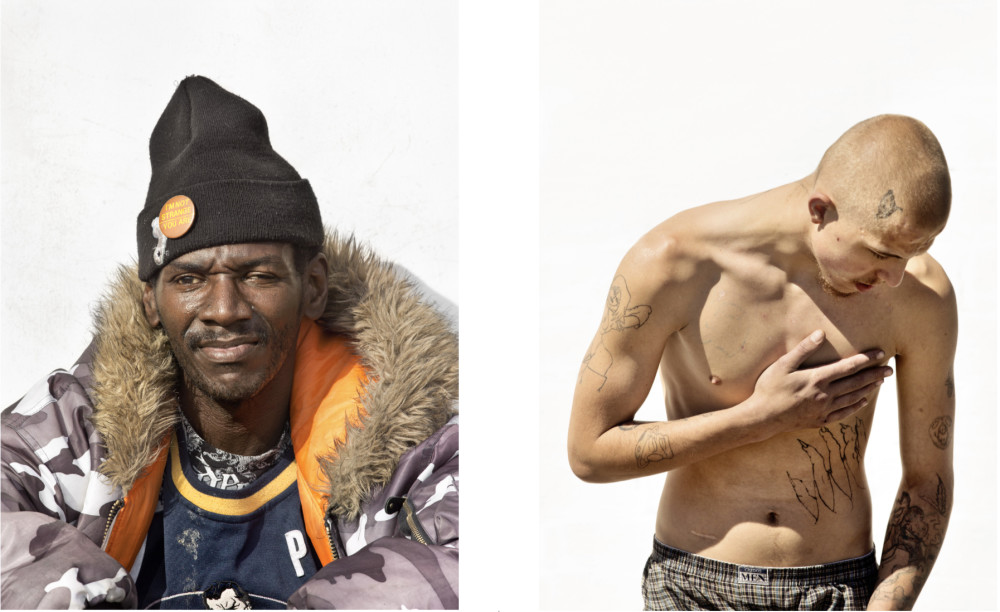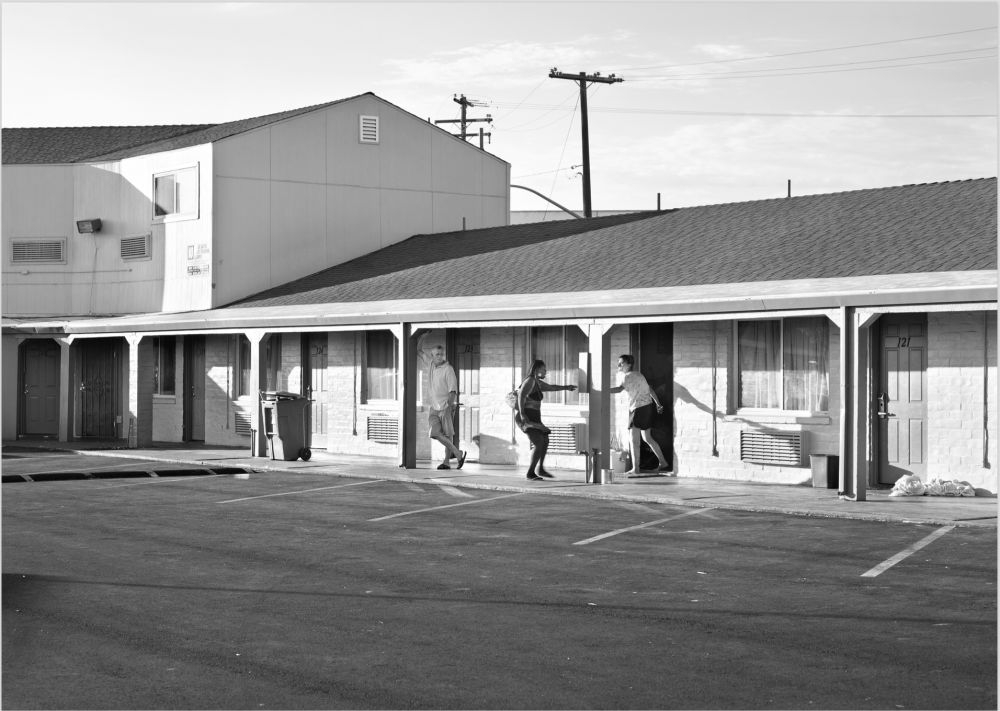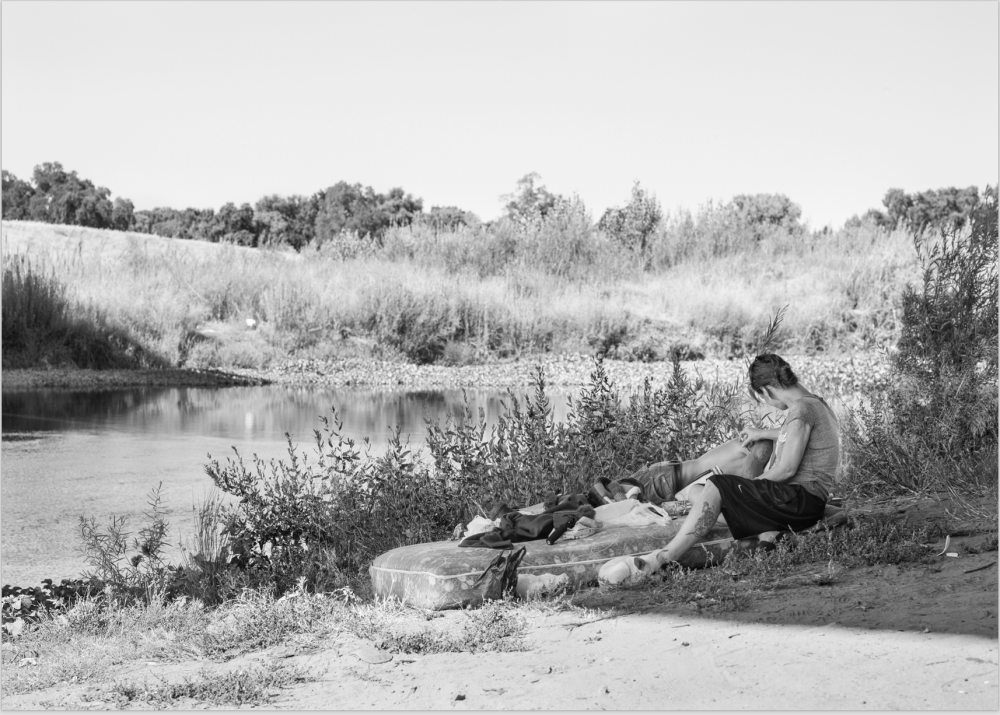Image above: Katy Grannan, Portrait, 2015. ©Robert Lewis
Sun reflecting off a blank background creates an indeterminate space. Women, men, children pose in front of void white, the illuminated extremes of their edges disappear in the glare, become pure light; shadows descend down the spectrum of their body, catch on their ridges and furrows, define their forms. Faces strain in the sunlight: skin between ear and nose is pulled taut over the skull, nostrils squint, lips are tugged upward into scowling M’s, wrinklegrids ripple out of quiet eyes. In the am- biguity of the space, these bodies become their own background and foreground, their own context, features coming into definition out of themselves. The focus is on the terrain of the subjects’ faces and bodies: the bare spaces between curling patches of hair, hills of bone and muscle and the valleys be- tween, skin smooth and rough, tight and slack.
 Images above: ©Katy Grannan, (left) Anonymous, Bakersfield, CA, 2011; (right) Anonymous, Modesto, CA, 2012. Courtesy of Fraenkel Gallery, San Francisco.
Images above: ©Katy Grannan, (left) Anonymous, Bakersfield, CA, 2011; (right) Anonymous, Modesto, CA, 2012. Courtesy of Fraenkel Gallery, San Francisco.
The photographs are more than portraits, they are landscapes. Not just that they track the landscape of the subjects’ features, but in doing so these photographs build a landscape of California’s Central Valley, where the subjects reside. This region of Agricultural America shifts annually between the dry desertheat of summer and floodfrequented rainyseason, when the Tule Fog drifts into the valley and obscures vision, a season of sight and a season of blindness. The region leaves its thumbprint (a reverse landscape) on the people who populate it. But amidst the forces of age, of weather, of gravity that press them into the Earth, there are signs on these individuals’ bodies of movement in the opposite direction, toward an apex of individuality, an assertion of identity.
The series is Katy Grannan’s The Ninety Nine. The title refers to Highway 99, which runs the length of central California. Like her previous series Boulevard, she photographs her subjects in front of white city walls. There is a certain continuity in the subjects to whom Grannan is drawn: a roughness, a rich physical vocabulary, a high level of expressiveness. Where most of the subjects of Boulevard were from L.A. or San Francisco, these subjects reside outside these metropolitan hubs, and there is noticeably less urban theatricality in the subjects of Ninety Nine compared with their Boulevard counterparts. The subjects of Ninety Nine come from Bakersfield, Modesto, Fresno; towns that the hopeful L.A. bound pass over without so much as peripheral acknowledgement. It is only the town names that identify the individuals, all of whom are otherwise credited as “Anonymous;” an inversion of the images them- selves, where the cities are anonymous, and the figure that is the focus of attention.
 Images above: ©Katy Grannan, (left) Anonymous, Modesto, CA, 2013; (right) Anonymous, Modesto, CA, 2013. Courtesy of Fraenkel Gallery, San Francisco.
Images above: ©Katy Grannan, (left) Anonymous, Modesto, CA, 2013; (right) Anonymous, Modesto, CA, 2013. Courtesy of Fraenkel Gallery, San Francisco.
Anonymity is something of an obsession for Grannan. Aside from The Ninety Nine and Boulevard, both of which find her approaching strangers on the street for portraits, her earlier work, The Model Ameri- can, had her finding subjects by placing an ad in the newspaper. Needless to say, those who responded were not professional models. As with any other personals ad, the responses were from those seeking the focused attention of some Eye, some fixated, infatuated gaze to lift their shape out of the white void of routine. Grannan, in placing the ad, is on the opposite end of the relationship: legitimization and consummation sought in the act of seeing, in the choice of who is seen.
In The Ninety Nine, the path that Grannan takes through California consciously mirrors the one taken by photojournalist Dorothea Lange in her Depression Era quest to document the overlooked, the ig- nored, the passedover, in the towns and among the populations hit hardest by the economic downturn. Lange’s ideology is a clear influence on Grannan: an image from The Ninety Nine of a shirtless man holding his young daughter resembles Lange’s iconic Migrant Mother. Grannan, like Lange, under- stands the necessity to capture not only the pedestaled Elect, the stoneperfect who bisect the sky like statues, but also those below: who, in seeking reprieve from sunlight, have huddled within the statue’s elongated shadow. Here is the majority of humanity, who live and dream and pass in oblivion. But it is of them that the Photograph dreams, because only they can complete the full, textured landscape of humanity. Both Lange and Grannan understand that photography has a potential for objectivity that is only realized when it captures those who might otherwise pass unseen, the millions unnamed and unanointed who play out their lives beneath the fog.
Grannan has stated in an interview, referencing one of her photographs from Boulevard, “I love the spirit of someone like the eightyyearold woman who still wears bright lipstick and eyeliner. She de- serves to feel gorgeous, and she is.”1 For Grannan, cosmetic indulgences are more than superficialities; they speak to a human opposition to anonymity, and are signs of life on otherwise weathered and worldweary faces. In Ninety Nine, these simple vanities (pink hair dye, gold helmets, leather jackets, colorful bathing suits, garish makeup, tattoos) work to name the nameless individuals; to give them a history and identity; to situate them within the context of a human drama. Playing out on the faces and bodies of each of these individuals is a struggle between a selfasserted identity and an external world that works to erase it. Each photograph is a staged dramatic encounter between the individual and the indifferent California sun.
1http://dailyserving.com/2011/01/boulevardaninterviewwithkatygrannan/
 ©Katy Grannan, Kiki Pays Debt, Room 123, Traveler’s Motel, Modesto, CA, 2013. Courtesy of Fraenkel Gallery, San Francisco.
©Katy Grannan, Kiki Pays Debt, Room 123, Traveler’s Motel, Modesto, CA, 2013. Courtesy of Fraenkel Gallery, San Francisco.
 ©Katy Grannan, April and Robert on Mattress Under 9th Street Bridge, Modesto, CA, 2013. Courtesy of Fraenkel Gallery, San Francisco.
©Katy Grannan, April and Robert on Mattress Under 9th Street Bridge, Modesto, CA, 2013. Courtesy of Fraenkel Gallery, San Francisco.
by conor o’brien

